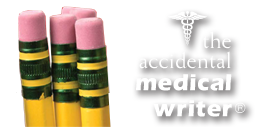 When we hire professionals, we expect them to know their job and to do it well. For example, when we hire a contractor to do work in our home, we expect them to bring their own tools and to clean up after themselves. Supplying tools and cleaning up aren’t typically line items in the contract, they’re just expected parts of the job. Contractors are professionals, and as such they should know what is expected and deliver on those expectations consistently with every job. In fact, professionals who deliver on the details without ever being asked are typically the ones who are hired back again and again. The same thing goes for freelance medical writers.
When we hire professionals, we expect them to know their job and to do it well. For example, when we hire a contractor to do work in our home, we expect them to bring their own tools and to clean up after themselves. Supplying tools and cleaning up aren’t typically line items in the contract, they’re just expected parts of the job. Contractors are professionals, and as such they should know what is expected and deliver on those expectations consistently with every job. In fact, professionals who deliver on the details without ever being asked are typically the ones who are hired back again and again. The same thing goes for freelance medical writers.
Whether we’re newbies or seasoned pros, it doesn’t hurt to remind ourselves of the details that define us as professionals and make our clients glad to pay our fees and eager to hire us again. Here are just of few of the big details you don’t want to miss:
Do your own literature searches. Even if a client tells you they are providing all the references you’ll need, it never hurts to check yourself. Perhaps the client has overlooked an updated guideline or isn’t aware of an article in this week’s issue of The New England Journal of Medicine. Finding it will make you a hero in the eyes of your client, and it will save you the frustration of having to rewrite perfectly good text when the client finally realizes they didn’t provide all of the latest information to you originally. We always build a little time into our estimates for a quick check of the literature, even if it’s not a line item in our estimate.
Always annotate. Medical communications companies often hire freelances to help with new business pitches. Sometimes these pitches can be as much work as the project they’re trying to get (if not more)! We’ve written tons of content–on disease states so clients can show off their knowledge of the therapeutic area, on current and emerging therapies so clients can demonstrate their market savvy, and on the strengths, weaknesses, opportunities, and threats (SWOT) the prospective company’s new product faces as it prepares to enter, or re-enter, the marketplace. When writing these documents (or, often, slide decks), the client tells us we don’t need to annotate because it’s just for a pitch. “We can catch up with all of that when we’re awarded the assignment,” they say. We know that after the fact is the worst time to source your content. So whether the client asks for it or not, we always annotate. In the long run, it makes our clients look better and it makes our lives easier.
Always source content when revising text. When we get a manuscript riddled with feedback from clients or authors, we frequently find statements the reviewer wants us to add. Not being professional medical communicators, reviewers don’t typically think about the rigors of medical/legal/regulatory reviews at all, let alone with the reverence we have for this process. They just write what they know to be true and leave it to us to make it so. Our steadfast commitment to ethical principles and practices will not allow us to write what we cannot document via legitimate and reputable sources to be true. This often sends us on a safari to uncover a source or sources to support what the reviewer wishes to add. Sometimes we’re successful, sometimes we come back empty handed. The point is, professionals don’t simply add text without referencing because the reviewer asked for it to be added. We add text when it can be supported (and reference it accordingly), revise text the reviewer has asked us to add when necessary to properly reflect the source we’ve identified, and insert a comment requesting suitable reference sources be provided so the requested text can be added when we are unable to source it ourselves. We’ve saved many a client from looking bad, or worse yet, from getting in trouble.
What details might you be overlooking or taking for granted? Don’t be deviled by them–turn them into diamonds so your clients will value you above all other writers.
Photo Credit: “Brillanten” by Mario Sarto – Self-photographed. Licensed under CC BY-SA 3.0 via Wikimedia Commons – https://commons.wikimedia.org/wiki/File:Brillanten.jpg#/media/File:Brillanten.jpg
